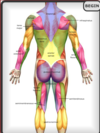Muscles Flashcards
(65 cards)
degree of movement depends on…
Origin and insertion create movement of body parts when the contract across joints. The type and degree of movement achieveed depends on how much movement the joint allows and where the muscle is located in relation to the joint.
Movement of Wrist Extensors
- Appendicular
- arm/forearm
- finger and wrist extension
sarcolemma
cell membrane
what happens in the muscle cells when a muscle contracts?
- when the sarcomere shortens, it means that the muscle is contracting
- why muscles are multinucelated –> to move at the same
- muscles contract –> absence of ATP
- for a muscle to contract, ATP must be present and be partially hydrolyzed
- muscles relax –> presence of ATP
- ATP needed to pump calcium ions out so that the muscle fibers can unlatch
- least energy to stay contracted
- (muscles contract when things die)

extended sub-maximal effort (marathon)
- depletion of all energy stores lead to a failure of calcium release
- repetitive overuse damages muscle fibers
aponeurosis
- sheetlike fibrous membrane
- binds muscles together or msucles to bone
explain the cause of the banding pattern visible in striated muscle
caused by the overlap pattern of the thick and thin filaments
Movement of Trapezius
- Axial
- Neck
- extension and abduction of head
- rotation, adduction, and fixation of scapula
When a muscle contracts (steps and bio shit)
- neuron releases electrical impulses
- transported thorugh T-tubules of sarcolema
- causes sarcoplasimic reticulum to release calium ions
- calcium ions attach to trpomysoin and reveal actin
- myosin attaches to actin and pulls
- etc
- if you constantly flush muscle with calcium ions –> contract and then twitch
- tryposmyosin only moves if calcium ions attach to it
- blocks myosin from attaching actin
- stays on top of actin

why are the reasons for fatigue in a long distance race different to those in a sprint?
- in a long distance race, ATP continues to be prduced aerobically until all energy supplies are exhausted
- in a sprint, ATP is produced anaerobically until the o2 debt has been repaid
Movement of Masseter
- Facial
- Head
- Axial
- closes mandible
Movement of Brachioradialis
- appendicular
- arm/forearm
- flexion of forearm
cross bridges
- ends of the thick myosin filaments are studded with head or cross bridges that can link to the thin filaments next to them
- when the cross bidges of the thick filaments connect to the thin filaments, a shape change moves one filament past the other
- two things are necessary for cross bridge formation:
- calcium ions, which are released from the sarcoplasmic reticulum when the muscle receives an action potential
- atp, which is hydrolyzed by ATPase enzymes on the myosin
- when cross bridges attach and detach in sarcomores throughout the muscle cell, the cell shortens
Muscles of Head and Neck

- orbicularis oculi - orbits eye; voluntary and involuntary
- levator labii superioris - action on a piece of skin
- zygomaticus minor and major - smile
- sternocaleidomastoid - sternum and clavicle



neuromusclular junction
- muscle fibers are innervated by the branches of motor neurons
- once an electrical impulse is received, it travels through the T tubules and then passes through entire sarcoplasmic reticulum
- NMJ is place where electricity passes to stimulate Ca ion release

Movement of Wrist Flexors
- appendicular
- arm/forearm
- wrist flexion, radial deviation
fixator muscles
- stabilizing
- don’t want to hyperextend
Movement of Brachialis
- appendicular
- arm/forearm
- flexion of forearm
short term maximal exertion (sprint)
- lactic acid build up lowers pH
- depletion of creatine phosphate
- buildup of phosphate affects the sensitivity of muscle to Ca
muscle fatigue
- decline in muscle’s ability to maintain force in a proglonged or repeated contraction
Movement of Levator labii superioris
- Axial
- Head
- sneering expression
describe the purpose of the connective tissue sheaths surrounding the muscle and its fascicles
- protect the msucle from friction and give structureal integrity to the tissue
- the perimysium (surrounding the fascicles) may also be involved in transmitting contractile movements across the muscle
explain the change in appearance of a myofibril during contraction
- I band: becomes narrower as more filaments overlap and the area of non overlap decreases
- H zone: disappears as overlap becomes maximal (no region of only thick filaments)
- the sarcomere: shortens progressively as the overlap becomes maximal

















